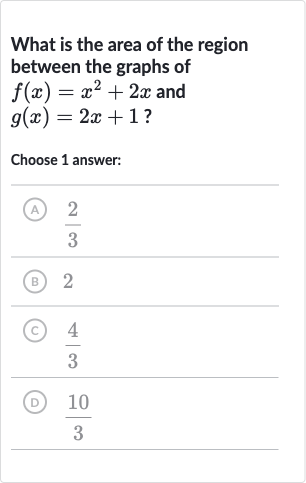Full solution
Q. What is the area of the region between the graphs of and ?Choose answer:(A) (B) (C) (D)
- Set Equations Equal: To find the area between the two curves, we first need to find the points of intersection by setting equal to .
- Solve for x: Set : .
- Calculate Limits of Integration: Subtract from both sides to simplify the equation: .
- Set up Integral: Take the square root of both sides to find the values of : .
- Substitute Functions: The points of intersection are and . These will be the limits of integration to find the area between the curves.
- Simplify Integrand: Set up the integral to calculate the area: .
- Integrate Function: Substitute the functions into the integral: .
- Evaluate Upper Limit: Simplify the integrand: .
- Evaluate Lower Limit: Integrate the function: from to .
- Find Total Area: Evaluate the integral at the upper limit: .
- Final Answer: Evaluate the integral at the lower limit: .
- Final Answer: Evaluate the integral at the lower limit: .Find the difference between the two evaluations to get the total area: .
- Final Answer: Evaluate the integral at the lower limit: .Find the difference between the two evaluations to get the total area: .The area of the region between the graphs of and is , which corresponds to answer choice (C).
More problems from Intermediate Value Theorem
QuestionGet tutor help
QuestionGet tutor help
QuestionGet tutor help
QuestionGet tutor help
QuestionGet tutor help
QuestionGet tutor help
QuestionGet tutor help
QuestionGet tutor help
QuestionGet tutor help
QuestionGet tutor help

